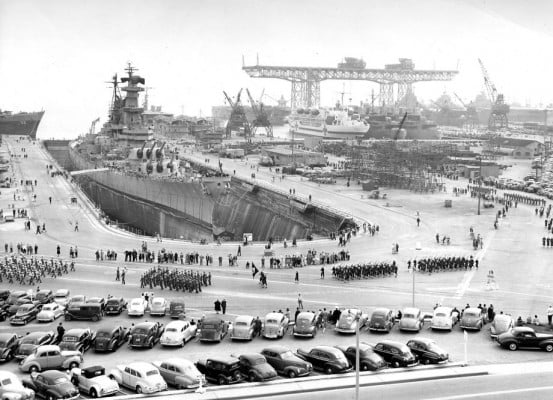San Francisco Naval Shipyard, better known as Hunters Point Naval Shipyard, used asbestos for many years in its daily operations. Many workers were exposed to asbestos at Hunters Point, and some developed mesothelioma. Lawsuits and ongoing cleanups continue to plague the site.
If you or a loved one have been diagnosed with mesothelioma, asbestos-related lung cancer, or asbestosis, you may be eligible for substantial compensation. There is currently over $30 billion in asbestos trust funds, set up for those who are victims of asbestos-related diseases. Fill out our form to get a free Financial Compensation Packet. You’ll learn about the experienced mesothelioma lawyers in your area, how to get paid in 90 days, how to file a claim for the asbestos trust funds, and more.

Did Hunters Point Naval Shipyard Use Asbestos?
Hunters Point used asbestos in its shipbuilding and repair operations for many years. All shipyards in the U.S. used asbestos. During peak years of industrial asbestos use, it was prized for its insulating and fireproofing properties. Hundreds of parts on ships built between the 1930s and 1970s contained asbestos.
Hunters Point Naval Shipyard History
Hunters Point Naval Shipyard was founded in 1867 in San Francisco, California. It was originally built on dry, serpentine rock that contained natural asbestos.
- By 1916, the shipyard was not only the first dry dock for commercial use on the West Coast but also one of the biggest, with over 800 waterfront acres.
- Hunters Point Naval Shipyard began as a shipbuilding and repair service. In 1941, the U.S. Navy acquired the shipyard and renamed it the San Francisco Naval Shipyard.
- The shipyard continued shipbuilding and repairing throughout World War II, which included maintenance and modifications on submarines.
- Continuing on during World War II, the shipyard repaired 600 support and fighting vessels.
- In the meantime, the Navy Radiological Defense Laboratory (NRDL) was created at the shipyard, to decontaminate vessels involved in nuclear testing. This lasted until the late 1960s when budget cuts closed the program down.
- Operations at the site ceased in 1974. The Navy reactivated it in 1986 and finally shut down and deactivated the site in 1991 due to contamination that included asbestos.
Today, the Hunters Point site has been the target of cleanup and redevelopment. Issues with the cleanup have caused environmental pollution and health risks to nearby residents. Several controversies have slowed redevelopment efforts.
How Did Hunters Point Use Asbestos?
Hunters Point, like many shipyards, used asbestos as an insulating and fireproofing material. Shipbuilding and ship repair used hundreds of asbestos components, including:
- Insulation
- Pipes
- Cement
- Boilers
- Gaskets
- Valves
- Textiles
- Adhesives
Asbestos was also used in buildings, equipment, and vehicles. The Hunters Point site is also situated on top of natural asbestos deposits, which has also caused issues.
Who Was at Risk for Asbestos Exposure at Hunters Point?
Anyone who worked at Hunters Point during the years of asbestos use was at risk of exposure. Asbestos materials shed tiny fibers that are easy to inhale.
People who worked most closely with asbestos or even cut or manipulated asbestos materials had the highest risks of exposure. They were more likely to disturb and inhale asbestos fibers. These people include insulators, boiler workers, pipefitters, and ship repair workers.
Asbestos has lingered at the site long after it was officially used in shipbuilding and repair. People who worked at Hunters Point after the shipyard closed could have been exposed. Residents in the area have also been put at risk of exposure.
Hunters Point Environmental Cleanup and Controversy
Asbestos levels at the shipyard were so excessive that in 1989, the Environmental Protection Agency (EPA) designated Hunters Point as a Superfund site.
Cleaning up and attempting to redevelop the site have posed ongoing issues. One development company dug into the natural asbestos deposits below Hunters Point, releasing dangerous plumes of asbestos fibers. The company was fined, but the damage was already done.
Due to the high contamination levels at the shipyard and the natural deposits, area residents began having health issues. This has included a confirmed diagnosis of both mercury and asbestos in one resident’s bloodstream.
A fire also broke out at the shipyard in August 2000, putting residents at risk of exposure to toxic substances again.
During the 1980s, the city of San Francisco bought the shipyard site and turned it into a housing project for low-income families.
Soon after, the site’s inspection company was fined for failing to notify anyone of the risks. Shortly after that, residents were evacuated. Advocates and community groups continue to fight for proper cleanup of the site.
Compensation for Workers Exposed to Asbestos at Hunters Point
If you worked at Hunters Point and now have a diagnosis of an asbestos illness, you have a right to seek compensation. Contact a mesothelioma lawyer or asbestos law firm to learn more about your options.
Many victims of workplace asbestos exposure are eligible to seek compensation through a lawsuit or an asbestos trust fund. A lawsuit is usually filed against the asbestos companies that supplied shipyards.
Asbestos companies that went bankrupt cannot be sued, but they most often set up asbestos trust funds to compensate future claimants. You could qualify to make a claim with one of these trusts.
If you are a veteran, file for VA benefits. These include monthly disability compensation, compensation for dependents, and medical care.
Additional Help and Resources for Asbestos Victims
If you’ve been injured by asbestos, keep in mind that there is a good chance that you’ll qualify for considerable compensation. Don’t forget to fill out our free Financial Compensation Packet, filled with information on the experienced asbestos and mesothelioma attorneys in your area. If you have questions or need additional assistance, contact us at 800-793-4540.

Paul Danziger
Reviewer and EditorPaul Danziger grew up in Houston, Texas and earned a law degree from Northwestern University School of Law in Chicago. For over 25 years years he has focused on representing mesothelioma cancer victims and others hurt by asbestos exposure. Paul and his law firm have represented thousands of people diagnosed with mesothelioma, asbestosis, and lung cancer, recovering significant compensation for injured clients. Every client is extremely important to Paul and he will take every call from clients who want to speak with him. Paul and his law firm handle mesothelioma cases throughout the United States.
References
- U.S. Environmental Protection Agency. (n.d.). Superfund Site: Hunters Point Naval Shipyard, San Francisco, CA.
Retrieved from: https://cumulis.epa.gov/supercpad/SiteProfiles/index.cfm?fuseaction=second.cleanup&id=0902722 - Hunters Point Naval Shipyard. (n.d.). History.
Retrieved from: http://www.hunterspointnavalshipyard.com/ - Schwartz, G.M. (2022, December 5). The Elusive Quest for Environmental Justice at Hunters Point.
Retrieved from: https://www.earthisland.org/journal/index.php/articles/entry/the-elusive-quest-for-environmental-justice-at-hunters-point/ - NAVFAC. (n.d). Former Naval Shipyard Hunters Point.
Retrieved from: https://www.bracpmo.navy.mil/brac_bases/california/former_shipyard_hunters_point.html - Photo Source: U.S. National Archives. Public Domain

